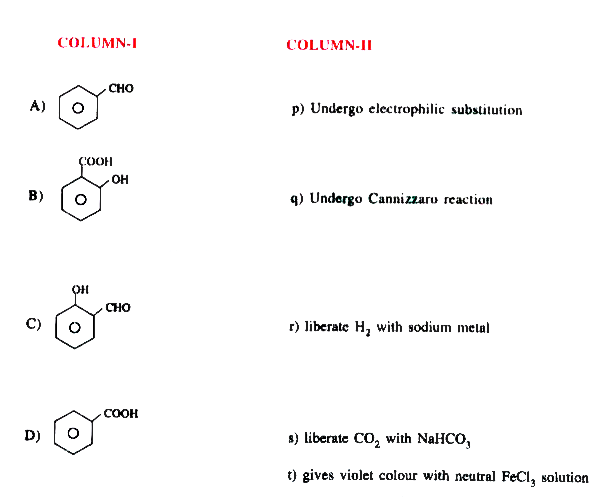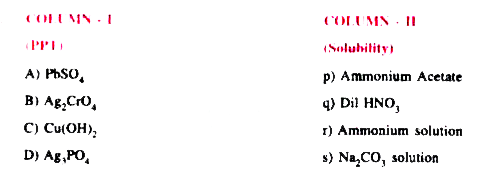Match the following questions
 Solution in Telugu
Solution in Telugu
The correct Answer is:A, B, C, D
Resistance : ohm , volt/ampere , Resistivity , ohm .m , Conductivity :ohm−1m−1
Topper's Solved these Questions
- BOOK - AAKASH SERIESCHAPTER - ELECTROCHEMISTRY EXERCISE - PRACTICE SHEET -3 (SINGLE OF MORE THAN ONE OPTION QUESTIONS )16videos
ELECTROCHEMISTRY
- BOOK - AAKASH SERIESCHAPTER - ELECTROCHEMISTRY EXERCISE - PRACTICE SHEET -3 (LINKED COMPREHENSION TYPE QUESTIONS(PASSAGE-I))3videos
ELECTROCHEMISTRY
- BOOK - AAKASH SERIESCHAPTER - ELECTROCHEMISTRY EXERCISE - PRACTICE SHEET -2 ( LINKED COMPREHENSION TYPE QUESTIONS (PASSAGE-II))3videos
ELECTROCHEMISTRY
- BOOK - AAKASH SERIESCHAPTER - DILUTE SOLUTIONSEXERCISE - EXERCISE - 1.255videos
DILUTE SOLUTIONS
- BOOK - AAKASH SERIESCHAPTER - ELEMENTS OF D - BLOCKEXERCISE - EXERCISE - 5.233videos
ELEMENTS OF D - BLOCK
Similar Questions
The hydrogen electrode when placed in a buffer solution of CH3COONaandCH3COOH in the ratio x:y and y: x has oxidation electrode potential EandE volts respectively at 25∘C (pH2=1atm) . pKa for CH3COOH will be :
05:49View SolutionThe cell potential (Ecell) of a reaction is related as ΔG=−nFEcell , where ΔG represents max. useful electrical work .
n=no. of moles of electrons exchanged during the reactino of reversible cell reaction d(ΔG)=(ΔV)dP−(ΔS).dT
at constant pressure d(ΔG)=−(ΔS).dT
∵ At constant pressure ΔG=ΔG=ΔH−TΔS.......(1)
∴ΔG=ΔH+T(d(ΔG)dT)P ......... (B)
(dEcelldT)P is known as temperature coefficient of the e.m.f of the cell
When ΔS increases, temperature coefficient of the emf of cell03:29View SolutionConductors allow the passage of electric current through them. Metallic and electrolytic are the two types of conductors. Current carriers in metallic and electrolytic conductors are free electrons and free ions respectively. Specific conductance or conductivity of the electrolyte solution is given by the following relation: K=cxlA
where, c=1/R is the conductance and 1/A is the cell constant, Molar conductance (∧m) and equivalence conductance (∧e) of an electrolyte solution are calculated using the following similar relations:
∧m=K×1000M∧e=K×1000N where, M and N are the molarity and normality of the solution respectively. Molar conductance of strong electrolyte depends on concentration : ∧m=∧0m−b√C
∧0m = molar conductance at infinite dilution
C = concentration of the solution b = constant
The degrees of dissociation of weak electrolytes are calculated asα=∧m∧0m=∧e∧0e
Which of the following decreases on dilution of electrolytic solution?02:32View SolutionWhat are the factor on-which solubility depends on ?
03:21View SolutionGive some examples for the ions with pseudo inert gas electronic configuration.
02:14View SolutionMatch the following question
 02:18View Solution
02:18View SolutionMatch the following questions
 03:11View Solution
03:11View SolutionMatch the following questions
 03:36View Solution
03:36View SolutionMatch the following questions
 02:44View Solution
02:44View SolutionMatch the following questions
 02:41View Solution
02:41View SolutionMatch the following questions
 01:58View Solution
01:58View SolutionMatch the following questions
 01:56View Solution
01:56View SolutionMatch the following questions
 03:34View Solution
03:34View SolutionMatch the following questions
 01:24View Solution
01:24View SolutionMatch of the following questions
 05:17View Solution
05:17View Solution

